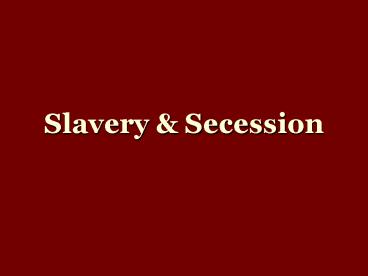Slavery - PowerPoint PPT Presentation
1 / 12
Title:
Slavery
Description:
Emancipation Proclamation. Lincoln saw emancipation ... In 1863, Lincoln issued the Emancipation Proclamation. Freed slaves only in confederate states. ... – PowerPoint PPT presentation
Number of Views:126
Avg rating:3.0/5.0
Title: Slavery
1
Slavery Secession
2
Dred Scott
- Dred Scott was a slave in Missouri.
- His owner took him to live in IL and WI.
- Scott sued for his freedom.
- He said that living in two free states made him
free. - Questions in court
- Was Scott a citizen (i.e. could he sue)?
- Is a slave in free territory no longer a slave?
3
Dred Scott Decision
- Courts decided that Scott was not nor could he be
a citizen therefore could not sue in court. - a subordinate and inferior class of beings
- no rights which the white man was bound to
respect - Decided that slaves in free states or territories
were not free. - Also decided that territories could not prohibit
slavery (because of property rules).
4
Douglas vs. Lincoln
- Both running for U.S. Senate for Illinois.
- Held public debates on slavery in the
territories. - Neither liked slavery, but neither wanted to get
rid of it where it already existed. - Both were racist.
5
Lincoln Is Elected President
- Lincoln lost the Senate in 1858 but won the
Presidency in 1860. - He was nominated because he was moderate in his
views. - South was outraged, because Lincoln didnt want
slavery in any new states.
6
(No Transcript)
7
Southern Secession
- South Carolina secedes from the U.S. in Dec. 1860
(shortly after election results). - Within a month, 7 states had seceded.
- Confederate States of America were formed.
- Jefferson Davis was chosen as their leader.
- Total states seceding in the end 11
8
(No Transcript)
9
North vs. South
- Northern Advantages
- Bigger population more soldiers
- More industry more war supplies
- Better transportation system
- Better army and navy
- Diplomatic recognition from overseas loans and
assistance - Slave population on its side
- Good leadership in Ulysses S. Grant
- Southern Advantages
- Fighting on home turf
- Good leadership (i.e. Robert E. Lee, Stonewall
Jackson) - Military tradition for men
10
Emancipation Proclamation
- Lincoln saw emancipation (freeing slaves) as both
a moral issue and a military strategy. - Helped gain support from abroad.
- In 1863, Lincoln issued the Emancipation
Proclamation. - Freed slaves only in confederate states.
- Freed slaves only in areas in which Union troops
were not in control. - Did not free slaves in states that remained in
the Union.
11
Conscription (The Draft)
- Conscription (the draft) was instated in 1862.
- Drafted men between 17 and 50 yrs. old (approx.).
- Allowed rich people to pay for substitutes!
- In the North, people could pay a fee to simply
avoid it altogether! - Draft riots occurredfamous one in New York.
- Rioted against fighting in a war against slavery.
- Violent action against abolitionists,
Republicans, and wealthy people.
12
Photography
- Just starting to develop during this time.
- Allowed people to capture photos of the war to
show people at home. - Showed people the reality of war (i.e. death,
destruction, not glamorous, etc.).































